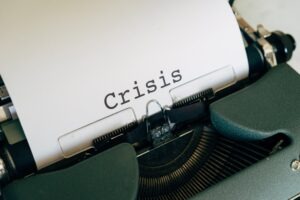Crisis Communication 101
Published on April 21, 2023, at 9:46 p.m.
by Alaina McDuffie.
If there is one truth about the public relations field, it is that crises will arise. From CEO scandals to mass layoffs, every organization is vulnerable to crises, highlighting the importance of crisis communication as a PR risk management strategy. After all, the way an organization responds to a crisis can have long-term impacts on its reputation, financial stability, and, in extreme circumstances, survival.

Due to the nature of crises and the need to disseminate accurate information quickly, PR professionals place an emphasis on organization preparedness. That said, how can PR professionals ensure that their crisis communication plans are ready should the unthinkable occur?
Two PR professionals with backgrounds in crisis communication share their best practices for preparing, honing and employing successful communication messages.
Understand the situation
Before a PR professional can respond to a crisis, they must first be able to identify one. PR crises manifest themselves in various forms — everything from a natural disaster to a product recall could fall into the crisis category.
Anthony D’Angelo, former chair of the Public Relations Society of America’s (PRSA) National Board of Directors and professor of

practice at Syracuse University, defined the term “crisis” simply.
“A crisis, in a clinical sense, is a business disruption,” D’Angelo said. “You can’t go back to do what you normally do when one of these hits. It will stop you from moving forward until you fix the problem.”
That said, some crises present themselves clearly, while others may be harder to identify.
Pushkin PR, a public relations firm with a specialty in crisis communication, recommends using the following diagnostic questions to evaluate potential crisis situations:
- Could this situation damage the reputation of our organization?
- Could this situation cause either an internal or external loss of trust?
- Is there any risk to the health, lives or safety of staff, clients, patients, providers or other stakeholders?
If the answer to any of these questions is “Yes,” then the situation is a PR crisis.
Be proactive
Oftentimes, the success of a crisis communication plan hinges on the proactivity of its PR professionals. In short, having a preexisting plan in place can save PR professionals valuable time when bad fortune strikes.
“Your enemy when something happens is time,” D’Angelo said. “You’re going to be in a defensive posture anyway [during a crisis], but at least [being proactive] can help you be in a more prepared defensive posture.”
That said, crisis plans are ineffective if they contain outdated information. PR practitioners should make a point to update plans on a regular basis to be best prepared.
Additionally, D’Angelo stated that “the best companies run simulations.” Simulating a crisis situation allows PR practitioners to tailor their plan for effectiveness before it actually occurs.
Simplify your messaging
Studies have shown that the stress that accompanies crisis situations can make it harder for individuals to process information.
For the PR professional, these findings prove that long, complex messages are ineffective during a high-stakes situation.
J. Suzanne Horsley, member of the University of Georgia Crisis Communication Think Tank and associate professor in the Department of Advertising and Public Relations at The University of Alabama, believes that PR professionals can learn how to simplify messages by looking to the Centers for Disease Control and Prevention’s (CDC) Crisis and Emergency Risk Communication (CERC) model.

“You’ve got to communicate differently with people under psychological stress,” Horsley said. “This model talks about how to repeat your information, how to send it out in really simple terms and how to approach people in really stressful situations to help them make informed decisions.”
The CDC said this model was created “to help health communicators, emergency responders and leaders of organizations communicate effectively during emergencies.” Through analysis of previous public health emergencies and significant research in the fields of public health, psychology and emergency risk communication, the CDC has created crisis manuals that help walk PR professionals through the crisis planning process.
Overall, these manuals can assist PR professionals in simplifying complex ideas into easily digestible messages that cut through psychological noise.
Lead with empathy

When dealing with severe crisis situations, a certain level of empathy is required. In fact, The Beryl Institute claims that “empathy is a powerful tool in times of crisis” that leaders should employ.
According to D’Angelo, the formula for dispersing information about a crisis can be tailored depending on the severity of that crisis. For example, PR practitioners should start at “the human level” when dealing with a high-level crisis. While some crises require telling the truth immediately and following quickly with empathy, D’Angelo recommends reversing this order when
necessary.
“If it’s something so horrible that somebody dies, [the formula] is empathy first, then truth and explaining what happens next,” D’Angelo said. “It’s just the right thing to do.”
As a rule, PR professionals should lead with empathy by alerting those most affected by a crisis first.
Expect resistance and backlash
In a report titled “CERC: Psychology of a Crisis,” the CDC broke down the four most common emotions felt by individuals during a crisis situation:
- Uncertainty
- Fear, anxiety and dread
- Hopelessness and helplessness
- Denial
While public hostility and backlash aren’t cited in that report as common emotional reactions to crises, an individual’s anger surrounding a stressful situation may be a result of one of these underlying emotions. Additionally, these emotional responses may serve as psychological noise that prevents target audiences from being receptive to PR messaging.
Many practitioners who are new to emergency scenarios may not expect publics to respond angrily, an idea that Horsley said she wasn’t initially prepared for either.
“I wasn’t expecting people to jump to conclusions and not be open-minded,” Horsley said. “You have to make sure you’re strategic about how you communicate because not everybody is on your side.”

When practitioners consider that the public might react negatively during a crisis, they are able to prepare in advance to diffuse tense situations. Additionally, the CDC provides crisis webinars on the CERC website to train practitioners how to respond if put in this position.
Implement best practices
Overall, crisis communication is an essential aspect of any organization’s PR strategy. Effective communication during a crisis can mitigate the negative impact of the crisis, prevent noise from clouding messages and even enhance the organization’s reputation. Ultimately, following these best practices may be the difference between an organization’s success or its failure.
As Warren Buffett said, “It takes 20 years to build a reputation and five minutes to ruin it.”




